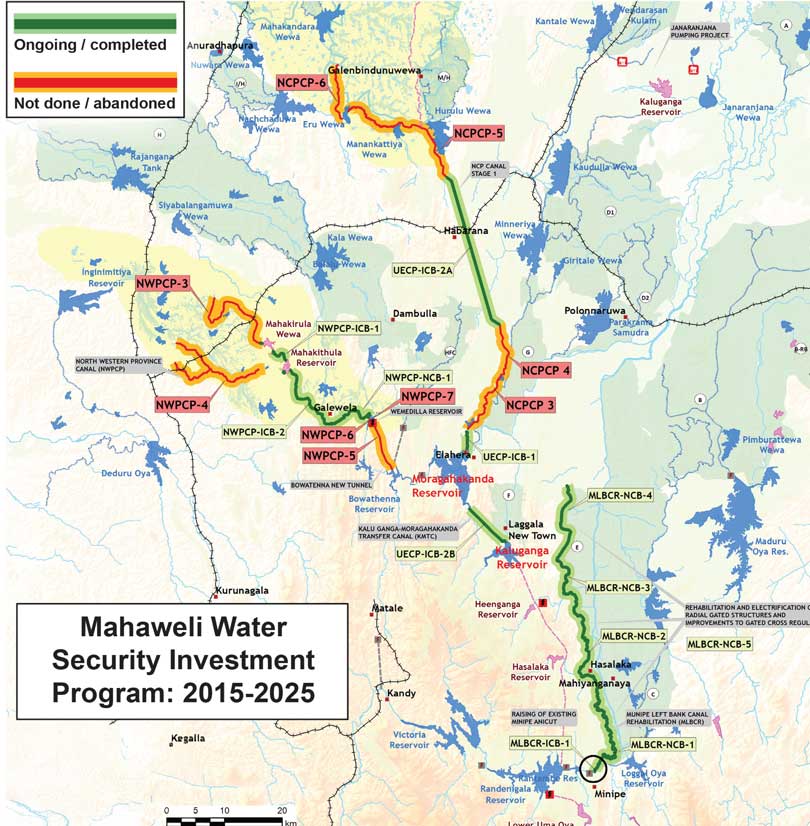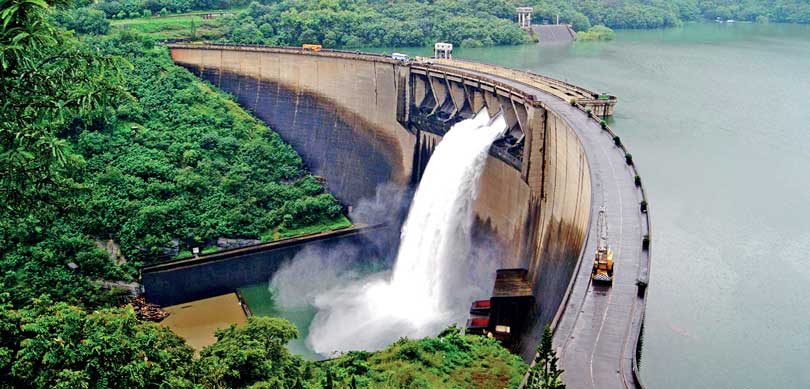As we all know, the Mahaweli Development Program was, for the most part, an outstanding success. Conceived in the 1960s, its first project, the Polgolla Dam, was commissioned in the early 1970s by Sirimavo Bandaranaike. J.R. Jayewardene raised the game with the Accelerated Mahaweli Development Program, which saw the development of several multipurpose reservoir projects between the late-1970s and mid-1980s. In all, these projects increased the irrigated farmland of Sri Lanka by around 250,000 acres. They also annually generate 2.5 terawatt-hours of renewable energy worth around Rs. 50 billion. The Mahaweli Development Program is among the most visionary climate resilience development programs in the world.
Although the ADB’s Board has the power to extend the MWSIP funding window beyond the 2025 deadline, this will happen only if the Government makes a forceful high-level request. To allow this extension, the ADB will have to break its own rule of a 10-year limit on projects of this kind. The External Resources Department has made a formal request to extend the project, but that’s been routinely turned down. But the ADB’s board granted an extension beyond the 10-year limit for a project in Mongolia after a high-level request was made
MWSIP
The latest phase of the Mahaweli Development Program is the Mahaweli Water Security Investment Program (MWSIP). Through a system of reservoirs, canals and tunnels, this ambitious initiative seeks to divert surplus Mahaweli water to the island’s water-starved North Central Province (NCP), Northwestern Province (NWP) and eventually further north, reaching up to Chemamadu Kulam Tank in the Northern Province. MWSIP aims to address irrigation and pipe-borne water needs of these dry provinces, benefiting two million people and increasing the extent of irrigated farmland by a further 250,000 acres. It is arguably the most ambitious water resource management program ever undertaken in Sri Lanka. And it is in trouble.
When it originally commenced in 2015, MWSIP was estimated to cost $ 675 million. The Asian Development Bank loaned the lion’s share, $ 453 million, while the Government pledged to contribute $ 108 million. There was a gap of $ 114 million, but in those heady Yahapalanaya days, the Government was confident that it could source co-financing to cover this. As luck would have it, the co-financing never materialised. But by then, work had already begun.
Disaster in the making
The funding gap only widened as time went by, due to changes in the designs of canals and other structures, higher than anticipated cost of compensating people who were affected by the construction, and significant cost escalation due to implementation delays. The ADB released its third and final tranche of $ 93 million in September 2024, but even if all the available funds are fully utilised by June 2025, which is when the ADB’s loan expires, only about 27% of MWSIP’s scope would be completed. There would be a staggering funding gap of around $ 870 million to complete the job as it was envisaged in 2015.
Unless the Government acts NOW, promptly and decisively, it risks the $ 563 million already spent being wasted, making this the NPPs first white elephant, similar to the Rajapaksa era projects such as Nelum Kuluna, the Matara-Mattala expressway, Hambantota port and Mattala airport.
If the Government acts fast, however, MWSIP has the potential to be resurrected and transform the rural agricultural landscape of the country, transforming into a big feather in the NPP’s cap.

First, the good news
The program involves three components. The first involves the rehabilitation of the 74-km-long Minipe Left-bank Canal, improving the sluices and gates, and raising the sides of the existing canal between Minipe and the Siripura region by about 10 feet. This component is complete, providing water for a third cultivation season to 15,500 farmer families cultivating some 18,000 acres.
Also largely complete is a scheme to facilitate sustainable agriculture in polytunnels and smart farms, thereby increasing productivity in chilli, onion and maize farms, in addition to aquaculture, poultry and dairy.
Then, the bad news
But that’s the least of it. From there, it’s downhill all the way. The second component of MWSIP, the 89-km-long NWP canal, comprises of 78 km of canal sections and around 11 km of tunnels plus two new reservoirs. This canal is intended to take excess Mahaweli water from Bowatenna to the NWP. Sadly, only around a 23-km section of the canal leading out of the existing Wemedilla Tank will be completed by the time MWSIP ends in June 2025. This is a mere 13% of the total scope of the works associated with the NWP canal.
Because neither the tunnel from Bowatenna to Wemadilla, nor the remaining canal sections, nor new storage reservoirs will be completed, it will not be possible to deliver water to the target recipients at the other end, northwest of Galewala. 40,000 farmers, each cultivating a plot of around 1 acre, have been betrayed. So have the 35,000 additional families hoping to benefit from household water supply connections. What has been achieved is in effect ‘a canal to nowhere’. The $ 15 million already spent will have gone, literally, down the drain, unless the rest of the NWP canal can be completed. Now, that looks very unlikely.
It gets worse
The third component of this ill-fated program is the NCP canal, a 96-km waterway comprising of 67 km of canal sections and 29 km of tunnels. It also includes the construction of a 9-km canal joining the existing Laggala Kalu Ganga reservoir to Moragahakanda. This will be the only completed part of the NCP canal system when the project ends in June 2025. It is now impossible to make the rest of the NCP canal system operational by then.
As a result, the 190 million cubic meters of water that was intended to be transferred annually from Moragahakanda to the NCP has nowhere to go. The 25,000 farmers who are waiting for water to irrigate their fields, and around 150,000 households expecting piped water connections, will be left high and dry.
Worse, the MWSIP will end in June 2025 with a gigantic, half-completed, 28-km long, 8-meter diameter tunnel of running beneath Habarana. The 67 km of canal sections connecting either end of this tunnel to Moragahakanda and Mahakadarawa have not even started yet. As a result, the multimillion-rupee JICA-funded water treatment plant built at Mahakandarawa cannot be commissioned: the farmers there are unwilling to share their water with the Water Supply and Drainage Board until additional water is available from the NCP canal. Unless the canal is completed as planned, this 28-km ‘tunnel to nowhere’ will be a white elephant pinned on the NPP.
Bad luck and bungling
The NPP has, of course, inherited this mess from its predecessors. The problem started with Maithripala Sirisena who, as Minister in charge of Mahaweli during his presidency, delayed the approval of crucial contracts. His dillydallying pushed back the implementation schedule by several years. When Gotabaya Rajapaksa took over, he insisted on completing MWSIP by the end of his term in 2024. This called for a second tunnel boring machine, enabling excavation from both ends. The cost? A staggering unbudgeted $ 50 million. Then, the COVID pandemic caused a further delay in 2020-21, followed by an inflation-driven price escalation following the Central Bank declaring itself insolvent in 2022.
Then, when he took over, Ranil Wickremesinghe ‘borrowed’ a further $ 50 million from the MWSIP budget to purchase muriate of potash (MOP) fertiliser for the 2022/23 Maha season, seeking to reverse Gota’s disastrous fertiliser ban. Then, his government bungled the issue of MOP to farmers, and the harvest failed. The government was forced to import $300 million worth of rice while sitting on over 40,000 tonnes of unused MOP in warehouses.
And so it was that three supremely incompetent presidents, Maithripala Sirisena, Gotabaya Rajapaksa and Ranil Wickremesinghe laid waste to this transformative $ 563 million project. It can now be rescued only by investing a further $ 870 million.
The really bad news
The worst news is that ADB’s 10-year funding window is rapidly closing. ADB funds for MWSIP will not be available after June 2025. At that point, the program will be stalled, with NCP canal and NWP canal only partially completed and unusable: they will be ‘kota uda’.
The NWP canal needs a further $ 370 million, while completion of the balance work on the NCP canal will need $ 500 million. Given the Government’s deal with the IMF, we will not be allowed to borrow this full amount in the foreseeable future. There is no choice but to abandon the NWP project where it stands. Too bad.
But the NCP project can be rescued. That $ 500 million package will probably come in 2026, from the ADB and other co-financing agencies. Meanwhile, the Government will be left to foot the bill for the two giant boring machines, which continue to excavate the 28-km tunnel beneath Habarana. The cost is a staggering Rs. 600 million per month which, once the ADB funds dry up, will have to come out of the Government’s scarce forex reserves. And if the Government fails to settle the payments owed for work done, there is a good chance that the contractor will sue for liquidated damages of between $ 50 and $ 70 million. So, if the Government doesn’t act NOW to prevail on ADB to extend MWSIP until the new $ 500 million comes in 2026, it could find itself in a big mess.
AKD must act NOW!
Although the ADB’s Board has the power to extend the MWSIP funding window beyond the 2025 deadline, this will happen only if the Government makes a forceful high-level request. To allow this extension, the ADB will have to break its own rule of a 10-year limit on projects of this kind. The External Resources Department has made a formal request to extend the project, but that’s been routinely turned down. But the ADB’s board granted an extension beyond the 10-year limit for a project in Mongolia after a high-level request was made.
I am writing this article in the hope that someone who reads it will be able to urge either President Dissanayake or Irrigation Minister Lalkantha to make an urgent appointment with ADB President Masatsugu Asakawa and dispatch a high-level delegation to Manila. This cannot be achieved by the Department of External Resources writing routine letters. We will then stand a chance of getting a one-year extension to this project, until the new $ 500 million facility comes in 2026, averting the massive trainwreck that is in the making.
The Mahaweli Titanic is heading straight for the iceberg, with a collision due just days from now. Time is short. I don’t want the Government to say it wasn’t warned. Unless it acts immediately, MWSIP is set to become the NPP’s Mattala International.
